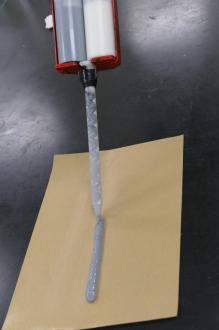News Release
Yokohama Rubber Establishes Basic Technology for High-Strength, High-Elasticity Urethane-Based Adhesive
2018.December.27
- Management relation
- Technical relation
Tokyo—The Yokohama Rubber Co., Ltd., announced on November 20 that it has established a basic technology for a two-component urethane adhesive with high strength and excellent elasticity. This technology will be applied to the development of adhesives for automobile body structures, an area expected to see rapid growth worldwide. It can be also applied to various industrial adhesives, including those used in electronic devices exposed to harsh heat cycles.
The automobile industry has entered into a once-a-century period of drastic change, with reduction of car body weights the highest priority. Multi-material structures combining lightweight materials such as aluminum and carbon fiber reinforced plastic (CFRP) with steel are rapidly coming into use, especially in Europe. This trend is increasing the need for structural adhesives because bonding the various materials used in these multi-material structures is difficult to do with traditional welding. Although the epoxy-based adhesives used to date have high strength levels, their low flexible elasticity to follow movement makes their use with multiple materials difficult. For that reason, the development of adhesives that can be used in multi-material structures is being earnestly pursued in Japan, including the establishment of a national project. Yokohama Rubber has been conducting research on adhesives that possess the high strength and excellent elasticity required for automobile structures. The research is based on the company’s renowned urethane adhesive technology for building and automobile window frames.
In the new technology, Yokohama Rubber succeeded in achieving maximum tensile strength of 20 to 40Mpa, comparable to that of epoxy- based adhesives with excellent elasticity unique to urethane adhesives with maximum elongation of 200 to 500%. These numerical values exceed the upper limit of the so-called banana curve that defines the performance range generally considered technically difficult to achieve. It also greatly improves urethane’s curability, helping overcome slow and/or imperfect curing caused by environmental conditions, such as temperature and humidity, which is considered one of the material’s weak points. The new technology realizes short takt times that enable both pot life and initial adhesion to be around 2 to 5 minutes. The new technology also greatly improves temperature resistance, maintaining stable physical properties in a much wider range from -30°C to 180°C compared with conventional urethane adhesives. In addition to its excellent dynamic durability, this urethane adhesive demonstrates stable strength and elongation characteristics when the deviation in the mixing ratio of the two components is kept within ±20%. Furthermore, its physical properties can be controlled by changing the mixing ratio, which makes it possible to adjust the physical properties as required by the different materials and/or bonding locations.
Yokohama Rubber launched its Grand Design 2020 (GD2020) three-year medium-term management plan in 2018. Expanding the company’s automotive components business is one of the initiatives being undertaken under the plan’s MB segment strategy to “Allocate resources on a priority basis to business fields of strength.” The company will continue to test this new technology and aims to use it to commercialize next-generation industrial adhesives.
Performance ranges of adhesives used in automobile structures

Comparison of tensile strength/elongation rate ranges for three conventional adhesive types (urethane, epoxy, acryl) and urethane adhesive created by Yokohama Rubber’s new technology. Newly developed product’s performance range exceeds the upper limits of existing adhesives’ banana curve showing technically difficult to achieve area.



